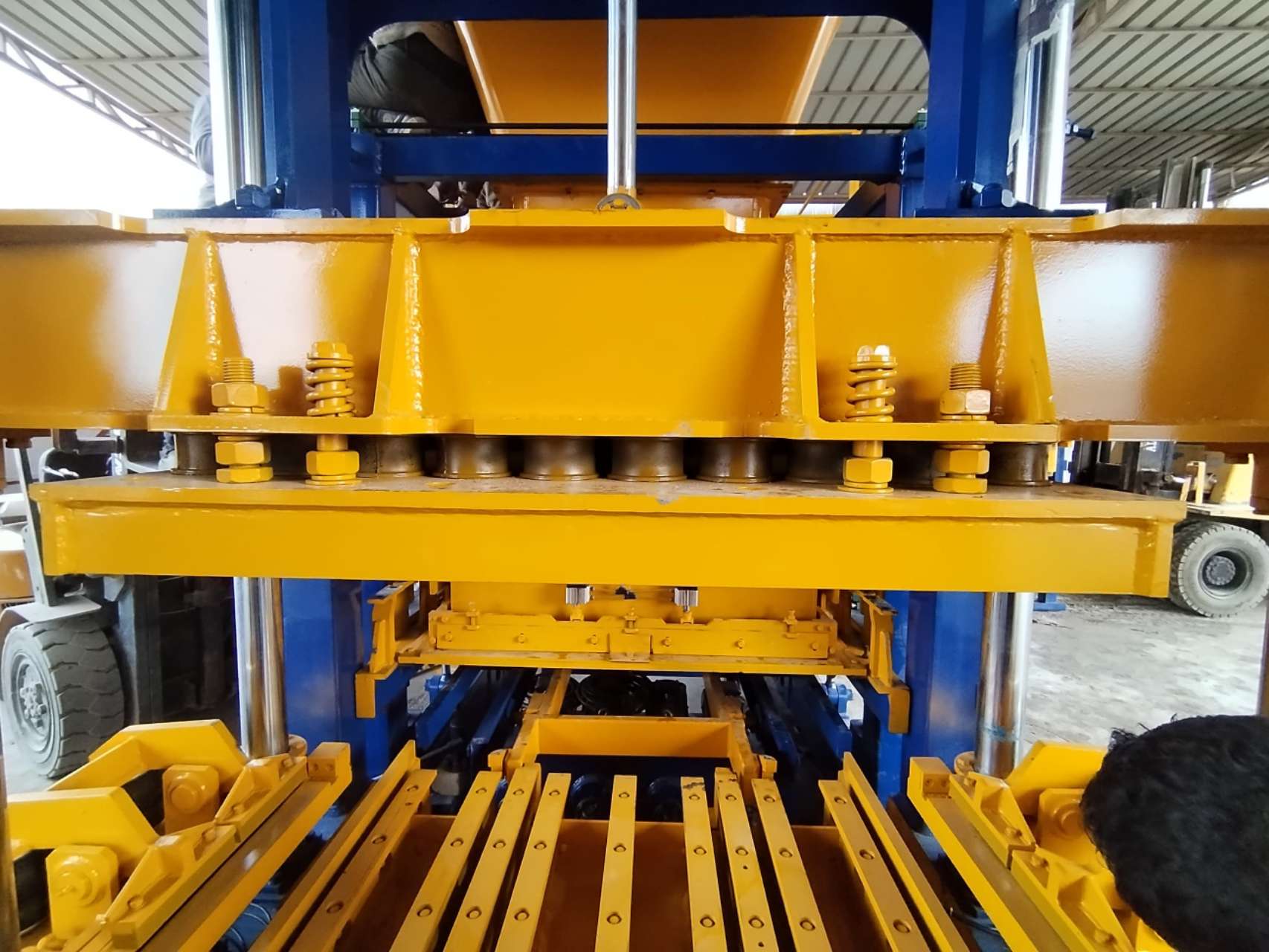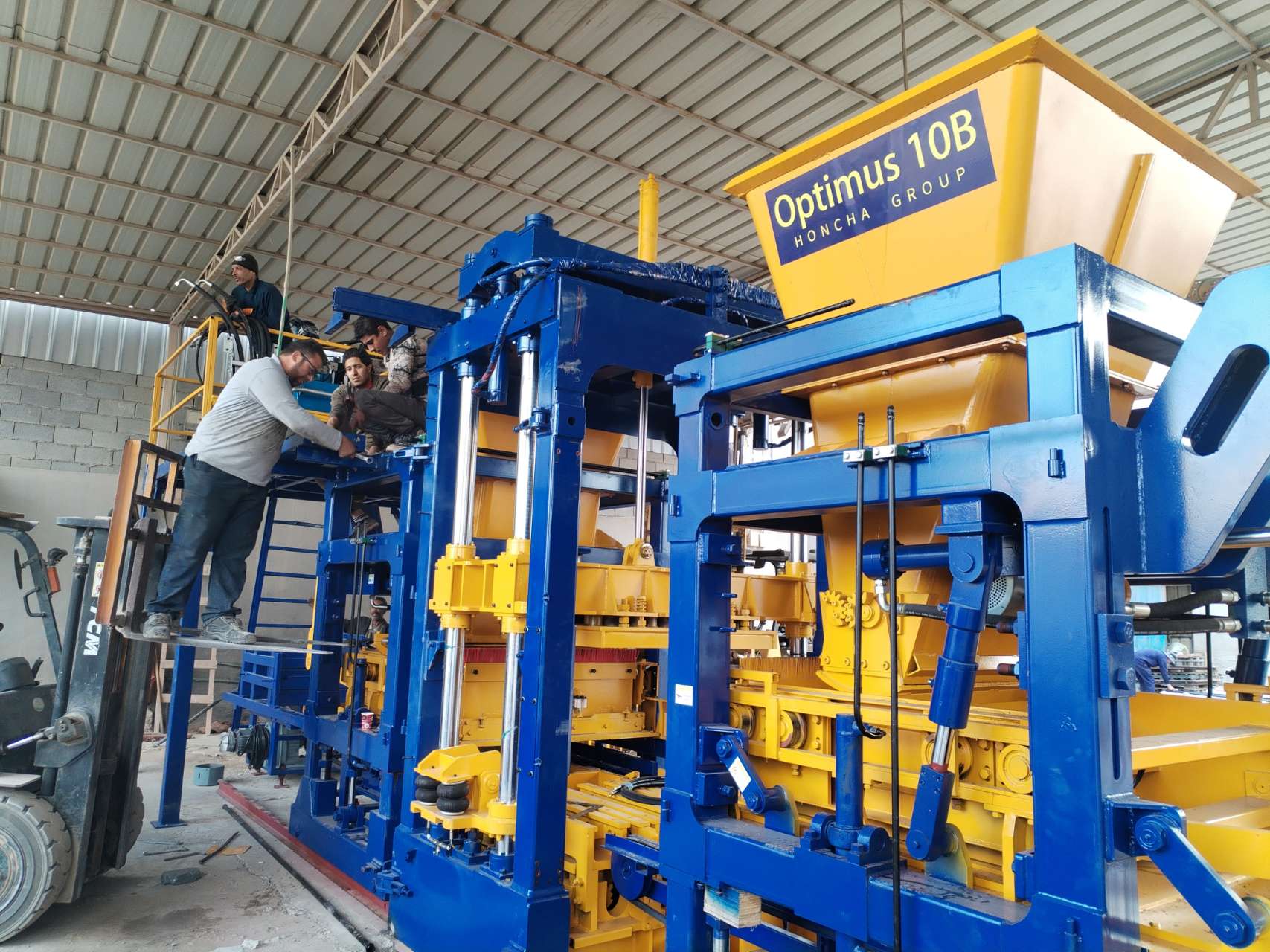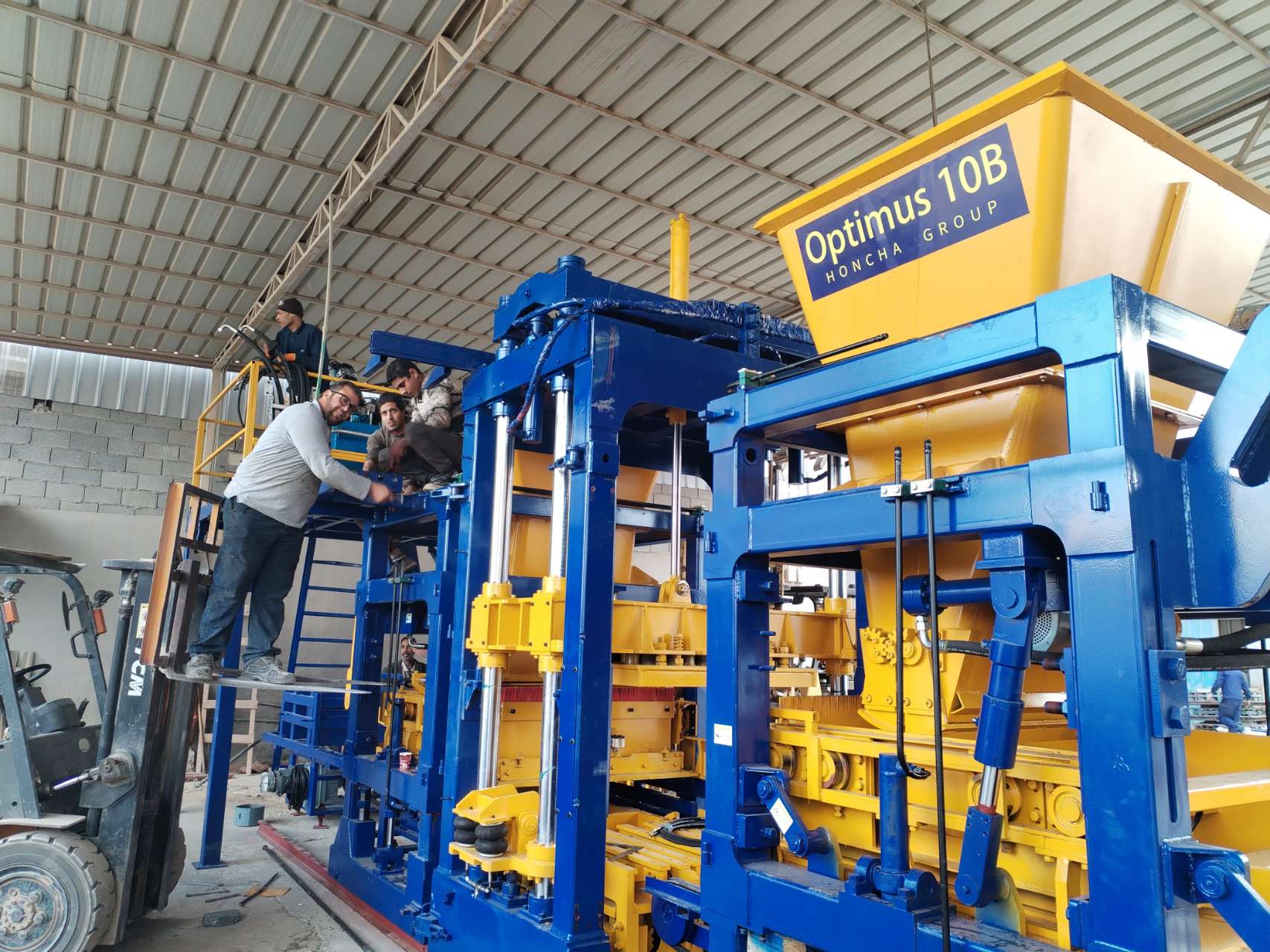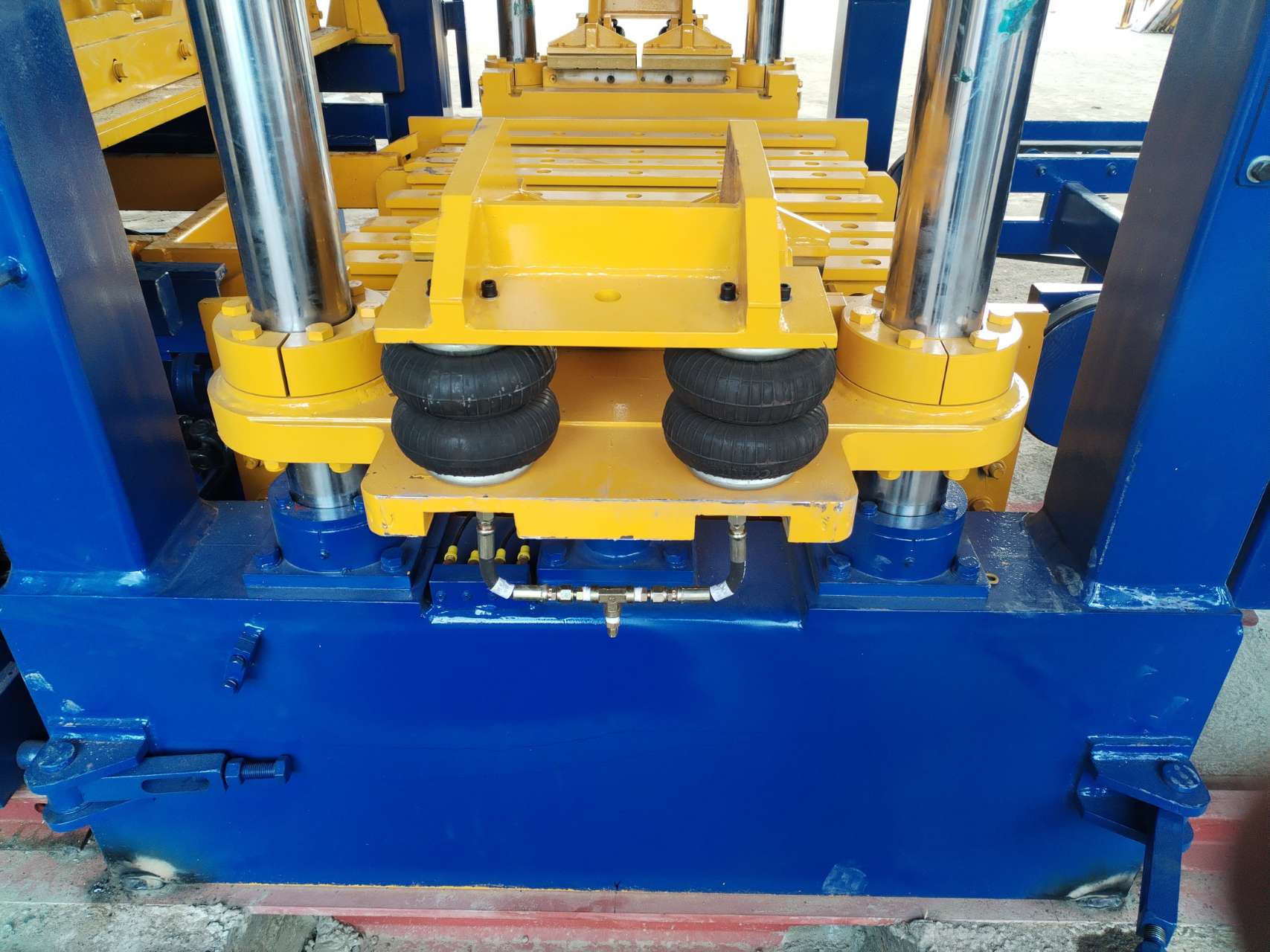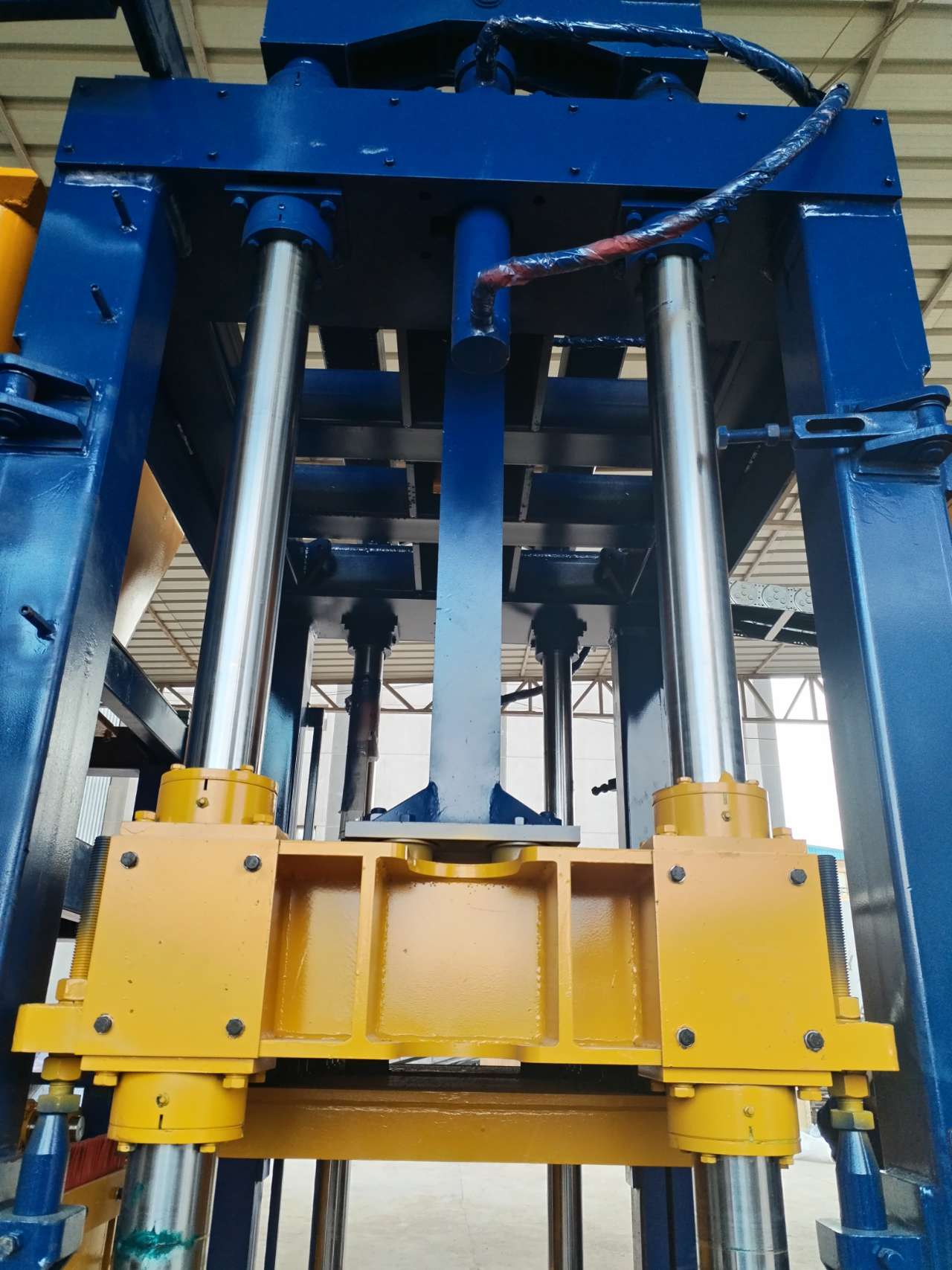Overall Appearance and Layout
In terms of appearance, the Optimus 10B presents the form of a typical large-scale industrial equipment. The main frame is mainly made of a sturdy blue metal structure. The choice of this color not only facilitates identification in the factory environment but also reflects, to a certain extent, the durability and industrial attributes of the equipment. The yellow hopper area at the top of the equipment is particularly eye-catching, marked with the words “Optimus 10B” and “HONCHA GROUP“. The hopper is used to store raw materials needed for block production, such as mixed materials like cement and sand and gravel. The overall layout is compact, and each functional module is arranged in an orderly manner, reflecting the consideration of space utilization and the rationality of the production process in industrial design. From the feeding, forming to the possible brick output link, a coherent operation line is formed.
Relationship between Structure and Working Principle
The blue frame part of the equipment constitutes the basic structure for its load-bearing and function realization. Various robotic arms, molds, transmission devices, etc. within the frame work in coordination. For example, the vertical and horizontal mechanical rods visible in the picture may be hydraulically driven components. The hydraulic system is crucial in the block forming machine. It realizes the pressing action of the mold through hydraulic power and extrudes and shapes the raw materials falling from the hopper in the mold cavity. The mold part is the key to determining the shape and size of the block. Molds of different specifications can produce various types of block products such as standard bricks, hollow bricks, and pavement bricks, meeting the needs of different application scenarios in construction.
Reflection in the Production Process Links
Speculating the production process from the on-site personnel operations and equipment structure: First, the raw materials are mixed in proportion by the batching system (which may be integrated in the equipment or the associated system) and then transported to the upper yellow hopper. The hopper uniformly distributes the materials to the forming mold cavity through the discharging mechanism; then, the hydraulic system drives the pressure head to move downward, applying high pressure to the materials in the mold cavity to shape the materials under the constraint of the mold. During this process, parameters such as the pressure control and pressure-holding time of the equipment will affect the quality indicators such as the strength of the block; the formed blocks will be transported to the pallet or conveyor belt through the subsequent brick output mechanism (not fully shown in the picture, which can be inferred according to conventional equipment in the industry) and enter subsequent processes such as curing, completing the transformation from raw materials to finished blocks.
Equipment Advantages and Industry Value
Block forming machines like the Optimus 10B have advantages such as high efficiency, energy saving, and multi-function in building materials production. High efficiency is reflected in the relatively high degree of automation and the ability to operate continuously. Compared with traditional manual brick-making or simple equipment, it greatly improves production efficiency and meets the demand for blocks in large-scale construction projects. In terms of energy saving, by optimizing the hydraulic system, material distribution system, etc., it can reduce energy consumption to a certain extent, conforming to the trend of green production in modern industry. The multi-function means that it can adapt to a variety of raw materials (such as the reuse of industrial wastes like fly ash and slag, which is beneficial to environmental protection and resource recycling) and produce different types of blocks, helping enterprises to flexibly respond to market demands. In terms of industry value, it promotes the industrial production process of wall materials, promotes the development of construction towards a more efficient and standardized direction, and also provides equipment support for the production of environmentally friendly building materials, helping to reduce the use of clay bricks and protect land resources.
Perspective of Operation and Maintenance
The personnel in the picture are working on different parts of the equipment, reflecting the complexity of equipment operation and maintenance. In terms of operation, professional personnel are required to be familiar with the hydraulic system control, material distribution parameter setting, mold replacement and debugging of the equipment, etc., to ensure the production of qualified products. In terms of maintenance, regular inspection and maintenance of hydraulic oil, transmission components, mold wear, etc. are required. The personnel in the picture may be carrying out equipment installation and commissioning, daily inspection or troubleshooting to ensure the stable operation of the equipment. Because once such large-scale equipment breaks down and stops, it will have a great impact on the production progress. Therefore, the standardization and professionalism of operation and maintenance are crucial to the production efficiency of enterprises.
2.Its structural design is regular. The yellow hopper at the top is used for loading raw materials, such as cement, sand and gravel, and other materials needed for brick – making. The blue frame structure in the middle is firm and should be the part that bears the key components for the operation of the equipment. The internal mechanical devices work in coordination to realize brick – making processes such as the pressing of raw materials. The yellow mechanical arm or transmission structure on the side is presumed to be responsible for actions such as the transportation of brick blanks and auxiliary forming during the brick – making process, ensuring the continuity of the brick – making process.
This type of brick – making machine plays a significant role in the field of building material production. It can process raw materials into brick products of different specifications, such as cement bricks, permeable bricks, etc., and is widely used in construction, road paving and other projects. Through automatic or semi – automatic operation, compared with traditional brick – making methods, it can improve production efficiency, ensure the stability of brick quality, and help enterprises with large – scale production. In the current context of energy conservation and environmental protection, it may also have certain designs for the rational utilization of raw materials and reduction of energy consumption, meeting the needs of modern building material production, and providing basic and important brick production equipment support for the construction industry.
When working, raw materials enter from the top hopper and go through processes such as uniform material distribution inside and high – pressure pressing to quickly form brick blanks. It has the characteristics of high efficiency and energy conservation, with a relatively high degree of automation, which can reduce manual intervention and improve production efficiency. It is suitable for the operation of large – scale brick factories, helping enterprises to reduce costs and increase efficiency in building material production. It is a relatively advanced model among unburned brick production equipment, providing strong support for the production of basic building materials for the construction industry. With stable performance and reliable quality, it has a certain degree of application in the market and promotes the development of environmentally – friendly unburned brick production.
Post time: Jul-03-2025

 +86-13599204288
+86-13599204288
